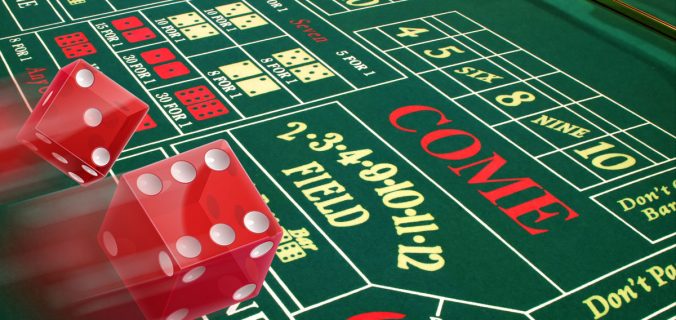Dice were among the very first objects created specifically to predict, interpret or manipulate fate. The ancient Egyptians and Greeks both made dice called astragals from animal bones. The common six-sided die, with the opposite sides adding up to the lucky number seven, has been in use since at least 1573 BC.
The best known and most popular casino dice game is Craps, which is derived from Hazard, a game which dates back to the 14th century and was once popular among high-stakes patrons in English gambling houses. The name “Craps” comes from the nickname “Crabs”, which is a roll of 1-1 in Hazard.
The modern game of Craps was developed by black Mississippi riverboat gamblers in the 19th century, borrowing heavily from the rules of Hazard.
Craps is fast, exciting and immensely popular, and the game has long been a favorite target of anti-gambling forces. Craps undoubtedly is responsible for many fortunes changing hands at dice tables in glitzy casinos, back rooms and alleys. It may even be guilty of something a little more serious: the Great Chicago Fire of 1871. Popular history names Mrs. O’Leary’s cow as the culprit, having kicked over a lantern in the barn, sparking the conflagration which destroyed much of Chicago. A Chicago businessman named Louis Cohn claimed, years later, to have knocked over the lantern himself during an especially exciting game of Craps, then laid the blame on the heifer. He was particularly remorseful, he said, because “I was winning.”
At first glance, Craps can be intimidating. There are numerous bets that can be made, and some of the terminology seems complicated, but the small amount of effort it takes to learn the game is well worth it. Many casino patrons consider Craps to be the game. Nothing in a casino generates as much excitement as a hot roll at the Craps tables.

The game of craps has a long, colorful history and is still going strong.
The game of Craps revolves around dice. Wagers are made upon the result of a single roll, or a series of rolls, of a pair of dice. Craps is a game of probabilities and odds, so any discussion of Craps will benefit by a brief explanation of the probabilities involved.
Since the game uses two dice, a shooter (the person rolling the dice) can roll any number between 2 and 12. It is important to understand that some numbers are more likely to appear than others on a single roll of the dice.
The following chart gives you an idea of which numbers occur most frequently. There are 36 possible outcomes for each roll.
Result of Roll
Dice Combinations of Combinations
Probability
Odds
2
1-1
1
2.77%
35:1
3
1-2, 2-1
Since 7 is the most frequently rolled number, it comes as no surprise that the game centers around this number.

The progress of a game of Craps is marked with a plastic “puck”, which is black on one side (OFF) and white on the other (ON).
The first roll of the dice in a round of Craps is called the come-out roll. The puck is turned black side up (OFF) during the come-out roll. The basic opening bet in Craps, placed just before the come-out roll, is called a Pass Line bet. The Pass Line bet wins immediately if the come-out roll is 7 or 11 (natural), and loses when the come-out roll is “Craps” (2, 3, or 12). If a 4, 5, 6, 8, 9, or 10 is rolled on the come-out roll, that number becomes the point. The puck is placed on the Craps layout over the box displaying the numbered rolled as the point with the white side up (ON).
The shooter now keeps rolling the dice until either the point is repeated or a 7 is rolled to end the round. If the point repeats first, the Pass Line bet wins. If a 7 is rolled first (seven out), the pass line bet loses.

